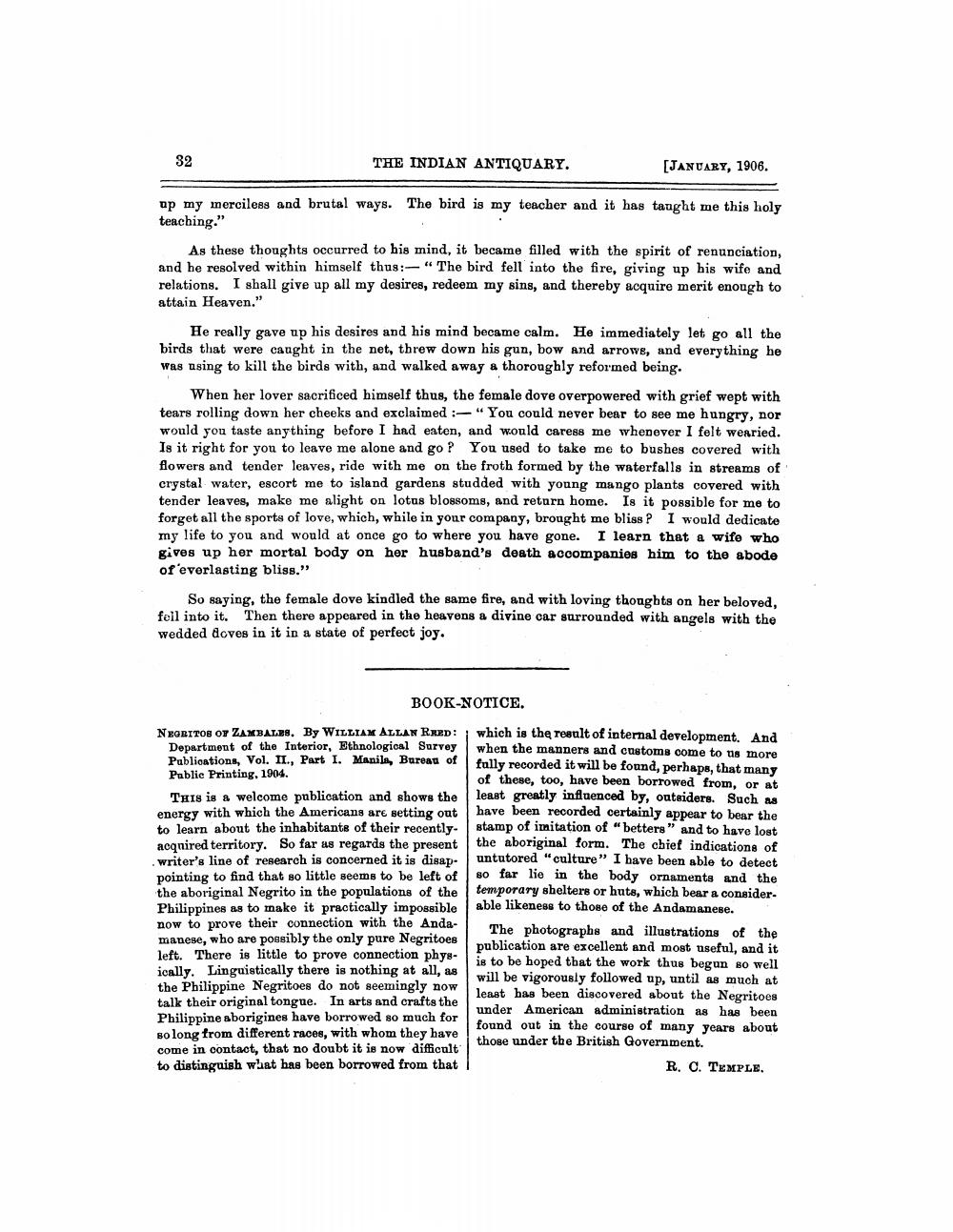________________
THE INDIAN ANTIQUARY.
[JANUARY, 1906.
up my merciless and brutal ways. The bird is my teacher and it has taught me this holy teaching."
As these thoughts occurred to his mind, it became filled with the spirit of renunciation, and he resolved within himself thus:-- "The bird fell into the fire, giving up his wife and relations. I shall give up all my desires, redeem my sins, and thereby acquire merit enough to attain Heaven."
He really gave up his desires and his mind became calm. He immediately let go all the birds that were caught in the net, threw down his gun, bow and arrows, and everything he was using to kill the birds with, and walked away a thoroughly reformed being.
When her lover sacrificed himself thus, the female dove overpowered with grief wept with tears rolling down her cheeks and exclaimed :-"You could never bear to see me hungry, nor would you taste anything before I had eaten, and would caress me whenever I felt wearied. Is it right for you to leave me alone and go? You used to take me to bushes covered with flowers and tender leaves, ride with me on the froth formed by the waterfalls in streams of crystal water, escort me to island gardens studded with young mango plants covered with tender leaves, make me alight on lotus blossoms, and return home. Is it possible for me to forget all the sports of love, which, while in your company, brought me bliss ? I would dedicate my life to you and would at once go to where you have gone. I learn that a wife who gives up her mortal body on her husband's death accompanies him to the abode of 'everlasting bliss."
So saying, the female dove kindled the same fire, and with loving thoughts on her beloved, foil into it. Then there appeared in the heavens a divine car surrounded with angels with the wedded dcves in it in a state of perfect joy.
воок-хотICE.
NEORITOS OY ZAMBALES. By WILLIAX ALLAN RRED:
Department of the Interior, Ethnological Survey Publications, Vol. II., Part I. Manile, Bureau of Public Printing, 1904.
This is a welcome publication and shows the energy with which the Americans are setting out to learn about the inhabitants of their recentlyaognired territory. So far as regards the present writer's line of research is concerned it is disappointing to find that so little seems to be left of the aboriginal Negrito in the populations of the Philippines as to make it practically impossible now to prove their connection with the Andamanese, who are possibly the only pure Negritoes left. There is little to prove connection physically. Linguistically there is nothing at all, as the Philippine Negritoes do not seemingly now talk their original tongue. In arts and crafts the Philippine aborigines have borrowed so much for so long from different races, with whom they have come in contact, that no doubt it is now difficult to distinguish what has been borrowed from that
which is the result of internal development. And when the manners and customs come to tis more fully recorded it will be found, perhaps, that many of these, too, have been borrowed from, or at least greatly influenced by, outsiders. Such as have been recorded certainly appear to bear the stamp of imitation of "betters" and to have lost the aboriginal form. The chief indications of untutored "culture" I have been able to detect 30 far lie in the body ornaments and the temporary shelters or huts, which bear a consider able likeness to those of the Andamanese.
The photographs and illustrations of the publication are excellent and most useful, and it is to be hoped that the work thus begun so well will be vigorously followed up, until as much at least has been discovered about the Negritoes under American administration as has been found out in the course of many years about those under the British Government.
R. C. TEMPLE.




